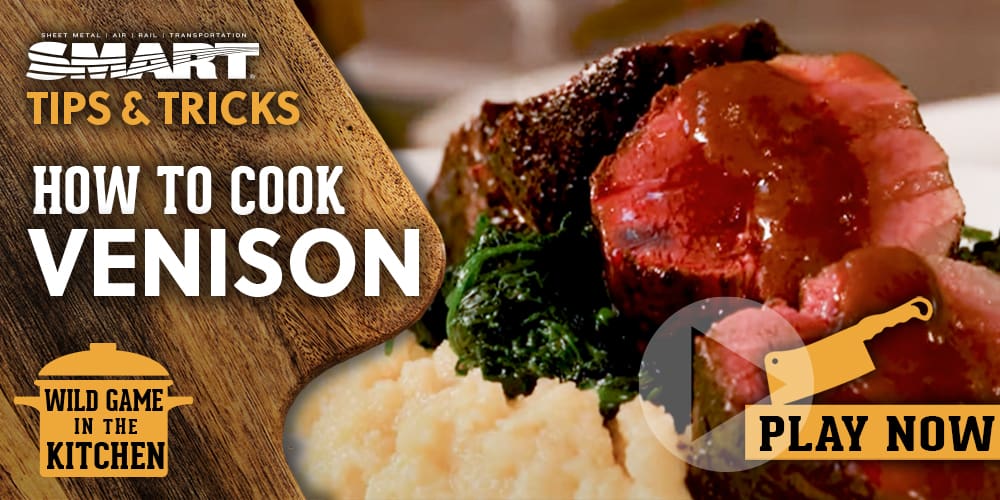 Do’s and Dont’s of Cooking Wild Game
Do’s and Dont’s of Cooking Wild Game
By PJ DelHomme
As hunters and anglers, we’re spoiled. We have the pleasure of serving friends and family the free-range organic protein we caught, killed, trapped, and chased. However, that wild game, fish, and fowl can be tricky to cook compared to store-bought alternatives. The term “gamey” is often tossed around to describe the taste of venison and other woodland creatures we bring home. Fear not. We’ll provide you with foundational know-how to cook everything from whitetail deer to wild turkey.
Wild Game Versus Store-bought Meat
Generally speaking, wild game meat is healthier than store-bought meat because it’s leaner. (See nutrition chart below.) All that “marbling” you see on a cellophane-wrapped T-bone steak is another name for fat. It’s what makes that T-bone so moist and delicious. Wild game lacks the marbling of domestic beef. The solution is simple. Just add a little fat.
“Butter, butter, and butter,” says Ryan Stepano, public affairs director for Operative Plasterers & Cement Mason International Association (OPCMIA). Stepano has always been into cooking, working in kitchens, and teaching himself to cook for his college roommates. Now, he’s a personal chef (foodsbyryan.com) who also sets up charity kitchens to support his hometown church.
“The best advice is don’t let the meat dry out. Always introduce fats—butter, oils, lard—to your meat, and you’ll never have a bad meal!”
Stepano loves to cook turkeys but says people tend to cook them incorrectly. “Many complain turkey is dry, but this is because they stuff their bird,” he says. Stuffing pulls moisture out of the meat and into the stuffing. Instead, rub a pad of butter under the skin and wrap a bacon weave on it to secure the juice, Stepano says.

Rub a pad of butter under the skin and wrap a bacon weave around turkey.
Care of Wild Game in the Field
For any kind of protein collected in the woods, lakes, ocean, or river, keeping the meat fresh is paramount to keeping it delicious. The infamous gamey taste is often due to poor handling in the field.
For venison, that starts with shooting a relaxed animal. Studies have shown that the more an animal is stressed when it dies, the tougher the meat will be. By killing a relaxed, calm animal, you ensure better meat.
Once you catch or kill an animal, the meat begins to break down. That works in your favor as long as the process isn’t too rapid and the meat spoils. It’s called aging, and that’s an art unto itself. Remove the guts and get the animal off the ground to cool the meat quickly. Throw it in a cold cooler, haul it back to the truck, or get it to the processor. By all means, do your best to keep it clean using game bags, tarps, or whatever will keep the dirt off.
And if you like to process your own wild game, Stepano says that using a vacuum sealer to package the meat is an absolute must. “If you are just wrapping it and throwing it in a freezer, your meat is subject to freezer burn,” he says. “That can limit its shelf life by more than half.”
More tips on caring for game in the field.
Cooking Techniques for Wild Game
Open any wild game cookbook, and you will be amazed at how many ways you can cook your critter. That’s not by accident. Cooking wild game can be tricky. That fur, fish, or fowl will typically have more flavor than its store-bought counterpart, but the odds of screwing it up are higher. That’s why some genius created marinades a long time ago.
“I use the internet for spices and ideas for marinades,” says Steve Powell, president of the United Food & Commercial Workers Local 881 and host of USA’s SMART Tip and Tricks: Wild Game in the Kitchen video series. Most marinades will have oil (fat), salt, vinegar, and a wide array of other spices. The goal of a marinade should be to enhance the flavor of the meat, not disguise it entirely. Consider using a brine bath (saltwater solution) for a few hours for waterfowl and upland birds.
And now for that looming question: how will you cook that game? Are you going to grill it, smoke it, make jerky, toss it in the slow cooker, braise it, or broil it? How about a reverse sear that’s all the rage? Maybe you’re into canning? Don’t forget about sausage, maybe some goose pastrami or bacon? The point here is that there are so many ways to prepare protein.
“Just take your time, especially if you’ve never done it before,” Powell says. For venison, cook tender cuts like backstraps and tenderloin hot and fast on a grill or in a cast iron pan with a little oil. Grind front shoulders into burger or jerky. Some great steaks and roasts hide in those hindquarters. Those get the low (temp) and slow (time) treatment in a slow cooker or on a smoker. The meat turns tender after a few hours.
Don’t be afraid to try different techniques to see what you (and your family) like best. Cooking meals of wild game together as a family is a great way to continue those good times afield.
Check out our new video series for some great wild fish and game recipe ideas!
Keep Your Edge
Powell and Stepano recommend that cooks invest in a good set of kitchen knives regardless of their level of expertise.
“The best item I have ever purchased, especially for breaking down or deboning, is a Shun boning knife with the convex blade,” Stepano said. “It gets into difficult areas a normal blade can’t. But the most important item to me while cooking any type of meat is a good sharp chef’s knife.
Follow these steps to keep your knife sharp.

The Union Sportsmen’s Alliance SMART Tips & Tricks series is proudly made possible by the following unions and union-friendly companies:












